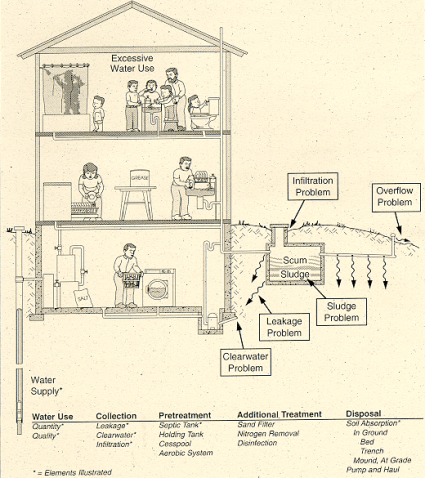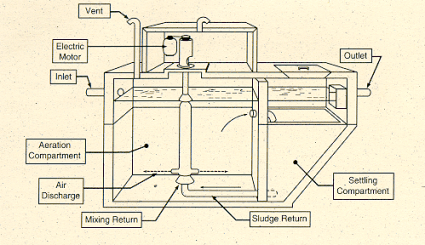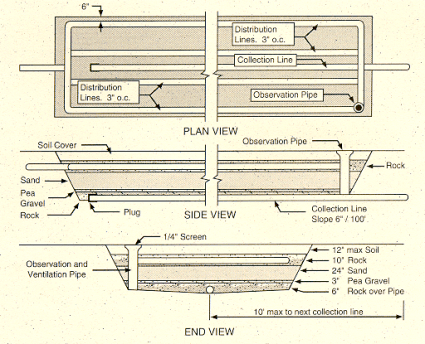Disposal Systems
To reduce the risk of wastewater contaminating water supplies, disperse effluent and maximize its contact with soil and plant roots.
Discharging treated or untreated wastewater from private systems directly to surface waters or ditches is illegal in Texas. Illegal wastewater discharges or wastewater surfacing above the drain field can endanger your health as well as the health of others in your community.
Subsurface Treatment Systems
Subsurface treatment and disposal, using soil absorption systems (trenches, beds, or mounds), is the common disposal system following septic tanks. There are, however, sites where soil absorption systems will not function properly and will endanger ground water quality. Unsuitable sites are those with impermeable soils, shallow rock, shallow water tables, or very permeable soils such as a sand or gravelly soil.
Suitable sites are those with deep, well-drained, well-developed, medium-textured soils (such as silt loam and loam). Soil beneath the disposal area must be unsaturated to provide adequate treatment. Unsaturated soil allows the effluent to remain aerobic and to flow through tighter soils, thereby filtering contaminants and giving soil microbes longer contact time with soil organic matter. Approximately 4 feet of unsaturated soil should be maintained beneath the disposal system to adequately remove pathogens and organic matter from wastewater.
Disposal systems that are downslope and far from the water well will better protect your water supply from possible contamination from wastewater.
Surface Treatment Systems
When compared to subsurface treatment systems, surface treatment systems promote more evapotranspiration (removal of effluent by evaporation and loss through plants). Increased evapotranspiration decreases the amount of treated effluent that can reach the water supply. However, disposal systems that apply the treated effluent directly on the ground surface must have an approved method of treatment and should disinfect the effluent before application. Keep the following application strategies in mind:
- The application of effluent in a surface treatment system should not produce runoff or ponding.
- Spreading the effluent over a larger surface area promotes maximum vegetative uptake of nutrients. The entire application area should be covered with vegetation so that most of the effluent will encounter plant roots before reaching ground water. The plant roots will utilize many of the nutrients in the wastewater.
Assistance with Failing Systems or New Designs
If you suspect your household wastewater treatment system is backing up or your distribution system is clogged, first contact a plumber or treatment system installer, who may have suggestions for extending the life of your system. The county public health office is the location to visit for permits to repair or replace a wastewater treatment system. Take the following steps to reduce any risk of contaminating ground water:
- Do not use septic tank cleaners that contain degreasing solvents such as TCE, which can contaminate ground water.
- Do not place more soil over a surfacing soil absorption field; this does not fix the system, and water will surface again.
- Do not pipe sewage to the road ditch, storm sewer, sink hole, drainage well, stream, or drain tile; this pollutes the water and creates a health hazard.
- Do not wait for the system to fail before pumping the septic tank. Once a system fails, it is too late to pump the tank.
- Remember that spreading the effluent over a larger area and placing the effluent shallower in the soil will decrease the chance of contaminating your water supply.
A properly designed, constructed and maintained septic system can effectively treat wastewater for many years, but it requires routine maintenance. For additional information on septic systems, contact your county Extension agent, local health department, or Texas Natural Resource Conservation Commission On-Site Wastewater/Agricultural Division (512) 463-8260.
Evaluation Table
The following table can be used to help agricultural producers and rural homeowners determine the risk that drinking water on a given property may be contaminated because of the management practices being used. For each category on the left that is appropriate, read across to the right and circle the statement that best describes conditions on your land. Allow 15 to 30 minutes to complete the table, and skip any categories that do not apply. Note any high risk ratings and take appropriate actions to remedy them. Strive for all low or low-moderate risk ratings.
Assessing the Risk of Ground Water Contamination from Household Wastewater Treatment
Glossary
Approved disposal site: A site for land application of wastewater or tank pumpage that meets state standards of the Texas Natural Resource Conservation Commission (TNRCC).
Cesspool: Covered excavation in the ground that receives sewage directly from a building’s sanitary drainage system. It is designed to retain the organic matter and solids and to permit liquid to seep into the soil. Cesspools are not allowed for construction and/or use in the state. They are considered unsuitable on-site wastewater disposal methods.
Clear water infiltration: Entry of water that does not need treatment into a treatment system; clear water may enter through tile drainage, unsealed joints, access ports and cracks.
Design capacity: Maximum volume of liquid that can be treated in a particular wastewater treatment system. For systems that include subsurface wastewater disposal and distribution, capacity is also based on the soil’s ability to accept and treat sewage effluent. In filling out the worksheet, if you do not know the design capacity of your system, use 150 gallons per bedroom per day as an estimate.
Effluent: Liquid discharged from a septic tank or other sewage treatment tank.
Holding tank: An approved watertight receptacle for collecting and holding sewage.
Hydraulic loading rate: The volume of waste discharged per unit area per unit time.
Off-site disposal: Disposal of wastewater or sludge at a municipal treatment plant or other approved disposal site.
Scum: Floatable solids, such as grease and fat.
Seepage pit (dry well): Underground receptacle constructed to permit disposal of septic tank effluent, treated wastes or clear wastes by soil absorption through its bottom and walls. Seepage pits are not allowed for construction and/or use in the state. They are considered unsuitable on-site wastewater disposal methods.
Sludge: Settleable, partially decomposed solids resulting from biological, chemical or physical wastewater treatment.
Contacts and References
For additional information, contact your county Extension agent or Natural Resources Conservation Service office.




Pingback: How does well water get contaminated?